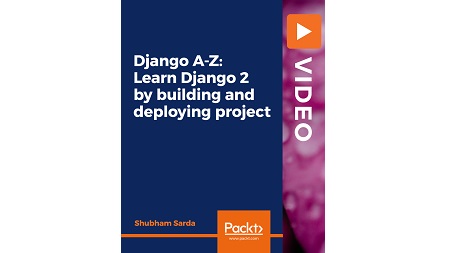
English | MP4 | AVC 1280×720 | AAC 48KHz 2ch | 5h 32m | 3.50 GB
Learn Django 2.2 – build real web applications with Python, Django, and SQLite3 and deploy them on a Heroku server
Welcome to Django A-Z: Learn Django 2 By Building & Deploying Projects!
This course will help you start your web development journey from scratch, step-by-step. This course touches on every important concept for beginners to the latest version: Django 2.
Throughout this course you will learn about:
- Setting up development environments (Libraries, Extensions, IDE’s, Virtualenv)
- Work with the Administration panel
- Working with a GitHub repository
- Push projects from local systems to GitHub
- Working with Django Heroku (STATICROOT, WSGI, gunicorn)
- Hiding secret keys, DEBUG , Allowed Host, Database Information
- Working with Django security and database updates
After completing this course, you will be ready to work on beginner-level projects as an intern, fresher, or freelancer and you will also be able to implement everything yourself! Most importantly, you will be ready to dive deep into a big available scope with Django in the future. Enroll now and I will make sure you learn all you need to know about Django 2!
Learn
- Learn about Django apps, templates, models, and migrations.
- Learn about the MVT (Model View Template) architecture
- Understand Django’s authentication system and foreign key concept
- Learn 4 important pillars for deploying (git, GitHub, Heroku, Heroku CLI)
- Write URLs, Views, and Models
- Registration functionality, Login, and Logout
- Integrating Crispy Form to improve registration functionality
- Usage of Django messages and forms
Table of Contents
Course Introduction
1 Course Introduction
2 Understanding Django
Project Setup
3 Setting Up Text Editor – VSCode
4 Setting Up Virtual Environment
5 Django 2.2 Version Update
Core Django – Starting Our Project
6 Startapp – Taskmate
7 Runserver For First Time
8 Django Flow and Django Structure
9 Urls and Views
Templates
10 Templates
11 Bootstrap
12 Base Template and Jinja 2
13 Static Folder and Improving Website Look
Model and Migration (Database Stuff)
14 Admin Panel
15 Models
16 Database Migrations
Fetch Data and Display on Template
17 Fetch Data from Database
18 Displaying Data on Templates
19 Adding Condition on Data
Django Forms
20 Adding Form and Accepting Input
Django Messages
21 Adding Messages and Alert Option
22 Close Option on Alert
Understanding CSS and Bootstrap
23 Understanding CSS and Bootstrap
Implementing CRUD Functionality
24 Deleting Queryset Item
25 Editing Queryset Item – 1
26 Editing Queryset Item – 2
27 Editing Queryset Item – 3
28 Adding Option – Mark Task as Completed
29 Adding Option – Mark Task as Pending
Pagination
30 Pagination Overview
31 Implementing Pagination – 1
32 Implementing Pagination – 2
33 Implementing Pagination – 3
Designing Task Page
34 Fixing URLs and Links
35 Fixing Task Page Design – 1
36 Fixing Task Page Design – 2
Designing Home Page Using Bootstrap
37 Designing Home Page – 1
38 Designing Home Page – 2
Accounts & Authentication
39 Introduction – Django Authentication System
40 Creating User Section
Registration
41 Registration Form
42 Register Templates
43 Register Views [Part I]
44 Register Views [Part II]
45 Adding Email Field in Forms
46 Improving Form Design with Crispy Forms
47 Adding Grid Layout on Registration Page
Login & Logout
48 Login – URLs, Views & Template
49 Login – Functionality Test
50 Login – Redirect URL
51 Logout
52 Quick Design Change
Adding Restrictions
53 Adding Header Restriction [Part I]
54 Adding Header Restriction [Part II]
55 Adding Page Restrictions
Relationship Between Task & User
56 Relationship Between Task & User
57 Adding Foreign Key
58 Updating Task Input Fields
59 Task of Logged-in User Only
Securing Our Application
60 Security Problem & Solution [Part I]
61 Security Problem & Solution [Part II]
Understanding Deployment Process
Working with GitHub and Heroku
62 Registering on Heroku and GitHub
63 Creating GitHub Repository
64 Working with requirements.txt and .gitignore
Django Environment Variable
65 Understanding Django Environ
66 Working with Environment Variables
67 Solving. env Errors [Part 1]
68 Solving. env Errors [Part 2]
Local System to GitHub
69 Push project from Local System to GitHub
Heroku
70 Working with Django Heroku
71 Working with StaticRoot
72 Handling WSGI with gunicorn
73 Empty folder Staticfiles
74 Configuring Secret Keys
Deploying on Heroku
75 Setting up Database and adding users
Thank You for Being Here!
76 Thank You for Being Here!
Resolve the captcha to access the links!